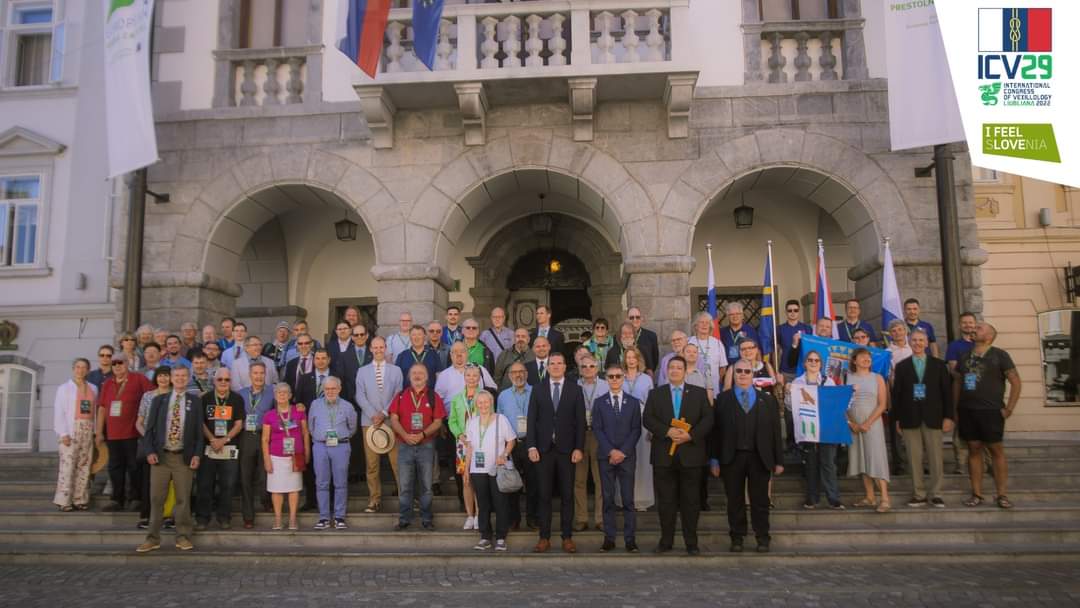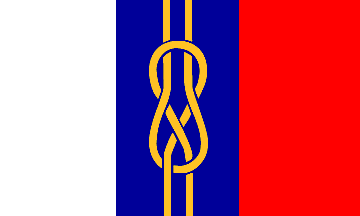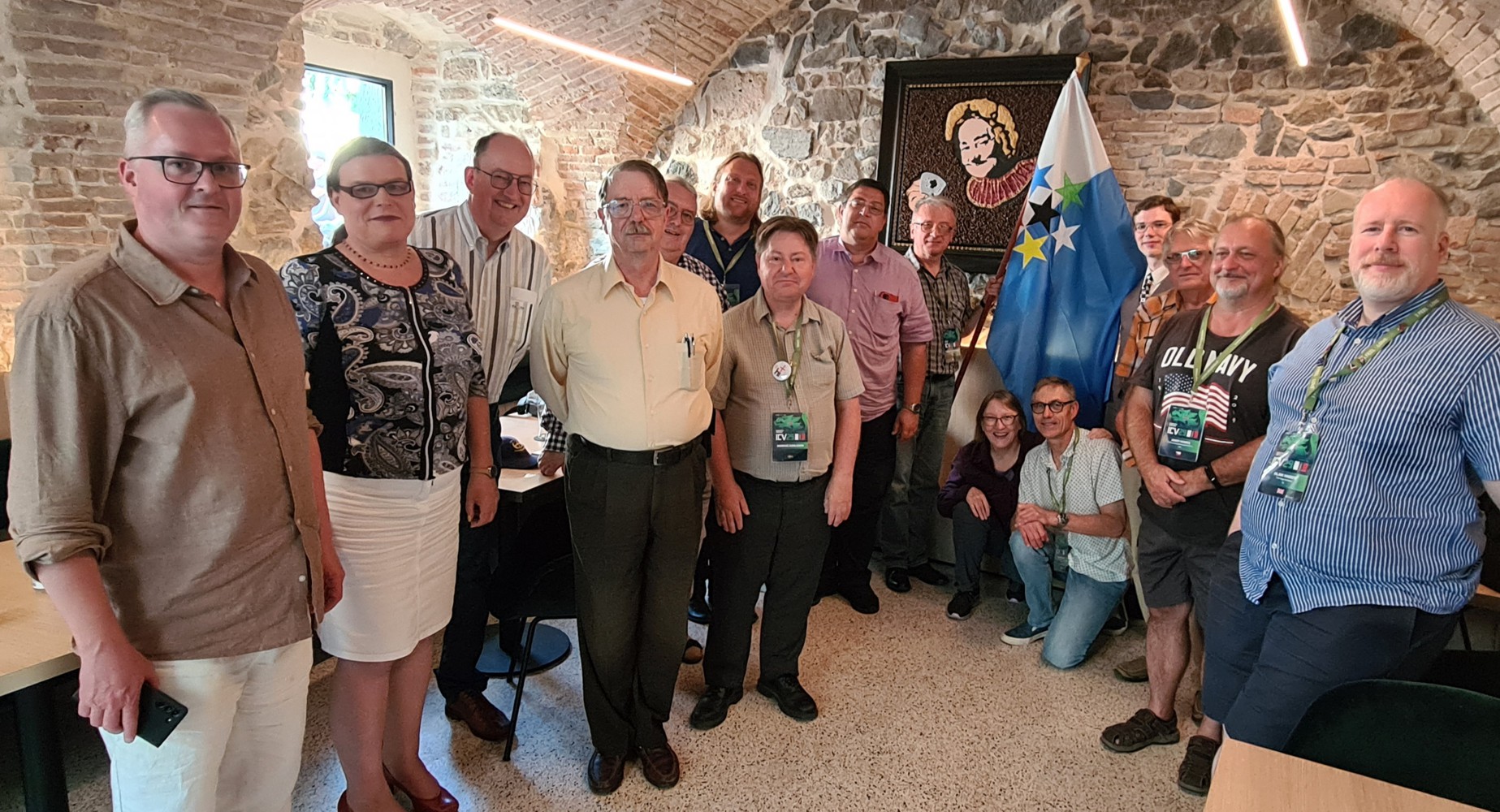 image provided by Bruce Berry, 11 July 2022
image provided by Bruce Berry, 11 July 2022[Click on image for larger version]

FOTW beschäftigt sich mit der Wissenschaft der Vexillologie (Flaggenkunde).
Alle auf dieser Website dargebotenen Abbildungen dienen ausschließlich der Informationsvermittlung im Sinne der Flaggenkunde.
Wir distanziert uns ausdrücklich von allen hierauf dargestellten Symbolen verfassungsfeindlicher Organisationen.
Last modified: 2022-08-05 by rob raeside
Keywords: international congress of vexillology | ljubljana |
Links: FOTW homepage |
search |
disclaimer and copyright |
write us |
mirrors
 image
by Aleksander Hribovsek, 21 July 2019
image
by Aleksander Hribovsek, 21 July 2019See also:
Greetings from Ljubljana. The ICV opened this morning and is now in full
swing. I met Tomislav which is a new "face" from FOTW.
In the meantime, here
is a copy of the Congress photo. Not a bad turnout with 60 odd delegates ...
Bruce Berry, 11 July 2022
 image provided by Bruce Berry, 11 July 2022
image provided by Bruce Berry, 11 July 2022
[Click on image for larger
version]
The Congress opened with an opening ceremony in front of the Ljubljana City
Hall. After the playing of the FIAV and Slovene anthems, the Congress flag was
placed above the entrance of the City Hall, alongside the flags of the EU,
Slovenia and Ljubljana. Chairman of the ICV Hosts, Heraldica Slovenica,
Aleksander Hribovsek and FIAV President, Zeljko Heimer, welcomed the
participants with Heimer then formally declaring the Congress open.
The
opening paper was by Bard Cosman on Divine Vexillifery: God's Flag in the
Judeo-Christian Tradition which provided an insight into how God's flag is
depicted by primarily Christians and Jews. This religious theme was followed by
Cederic de Fougerolle with a paper entitled Which Patron Saint for Vexillology?
Vexillological Iconography of the Christian Sanctoral. Unfortunately due to the
current travel restrictions in China, Zhao Xinfeng was unable to attend the ICV
in person. His paper on the Qidao Temple on the Central Axis of Beijing in the
Ming Dynasty was delivered electronically. The last paper in the initial session
before lunch was that by Attila Istvan Szekeres on Historical Flags from
Transylvania (15th - 19th Centuries) which also included actual replicas of the
flags mentioned in the paper.
After lunch there were two papers. The
first was a recorded paper by Kevin Harrington which dealt with Heroes on
American Flags. Finally Zeljko Heimer gave an overview of the 142 Vexillological
Periodicals published in 32 countries in over 30 languages since the first Flag
Bulletin was published in October 1961.
Bruce Berry, 11 July 2022
Jos Poels commenced the first session with a paper which dealt with February 14
1786 - The Dutch Flag Established which also covered the issue of when the upper
stripe changed from orange to red on the Dutch flag. Alain Raulett's paper
provided an overview of The Flag of Henry V and its Unknown Consequences. This
refers to Henri V of France, the Count of Chambord ... and not any of the other
Henry V's which he mentioned! The paper by Roman Klimes dealt with Ida Krauth
and the First Standard of the President of Czechoslovakia and how she came to
prepare and make the first flag used by the Cezch President in 1919.
After the break, it was my turn. My paper dealt with The forlorn, almost
forgotten, flag of Zimbabwe Rhodesia. This was the flag used for 102 days
immediately prior to the country becoming Zimbabwe in April 1980. Sebastia
Herreros' paper recounted his personal story about the flag on the island on
Cabrera which was followed by Andreas Herzfeld on the various proposals for a
flag for the League of Nations.
The first paper in the afternoon session
was a video presentation by Andriy Grechylo on the Ukrainian National Colours:
history, myths and fakes. Given the current situation in Ukraine, and the now
widespread display of the Ukrainian colours of blue and yellow, this provided
many useful insights. The final paper of the session was by Jovan Jonovski on
Phenomena of the Mijaks Flag.
The FIAV General Assembly was held after
the afternoon tea break. I will provide an overview of the outcome of the
meeting in a separate message.
Bruce Berry, 12 July 2022
The 27th General Assembly took place in Ljubljana on Tuesday.
44
member associations were present and following the report-backs by the
President, Zeljko Heimer, the Secretary-General, Bruce Berry and the
Secretary-General for Congresses, Graham Bartram consideration was given to the
applicants which applied for membership. Each applicant (further background in
Info-FIAV No. 55) was given an opportunity to make a short presentation about
their respective associations/institutions prior to a vote being taken:
I
am pleased to announce that the following associations/institutions have been
accepted as members of FIAV, namely:
The Institute of Genealogy,
Heraldry, and Vexillology (Lithuania)
Transylvanian Heraldic and
Vexillological Association
Vexillological Society of Singapore.
The
Proceedings from ICV 26, held in Sydney in 2015, were distributed earlier this
year, while it was reported that the Proceedings from ICV 27 (held in London in
2017) and ICV 28 (held in San Antonio in 2019) are still being prepared.
Following a short presentation by the Société française de vexillologie (SFV),
it was agreed by unanimous vote that ICV 31 will be hosted by SFV in Paris in
2026. A report-back on the preparations for ICV 30, to be held in Beijing in
July 2024, is to be provided by the Vexillological Research Center of China on
Friday morning.
In terms of Article 8 of the FIAV Constitution, a member
which does not attend three consecutive meetings of the FIAV General Assembly
will be deemed to have voluntarily resigned. Accordingly, the Magyarországi
Zászló Társaság (Hungarian Flag Society) is no longer a member of FIAV as it has
not attended an ICV since 2015.
The minutes of the meeting will be
included in the next issue of Info-FIAV.
The announcement of FIAV Awards
and presentation of certificates will be made at the Final Banquet of the ICV
which is to be held on Friday evening.
Bruce Berry, 12 July 2022
On Wednesday delegates were taken on tour to various Museums in Ljubljana and
surrounding area. At the first we were shown the 13m Slovenian flag which was
raised when independence was declared in June 1991. Numerous other flags and
banners which were used in Slovenia from the turn of the last century were on
display.
The displays in the National History Museum are divided into the
various periods of Slovene history, with a number of vexillological artifacts
from the pre- and post-World War II era being in on display. The national flag,
and flag of Slovenia when it was part of Yugoslavia, are on display at the
Military Museum we visited in Pivka. Examples of military vehicles, aircraft, a
submarine etc are also on display here too.
We were also shown a Yugoslav
Communist Party flag with mourning ribbon that was flown following the death of
former Yugoslav President, Josip Tito in 1980. We were also privileged to see
various other Communist Party and partisan flags used before and during WWI and
WWII.
Following its declaration of independence, there followed a brief
10 day war between the Slovene Territorial Defence Force and the Yugoslav
People's Army following which the Brioni Accords were signed recognising its
independence.
Bruce Berry, 17 July 2019
The third day of presentations began with a very interesting overview of
Municipal Gonfaloni and Flags in the Italian Province of Trento. This was
followed by Dominique Cureau proving an overview of the Communal Flags in French
Region Sud. Interestingly only 152 out of the 963 communes (16%) in the region
have a distinctive flag, with the majority of those that do being located along
the Mediterranean coast. Krystof Huk then presented a paper on the Czech and
Slovak Road to Communal Flags which traced the outline of the development of
communal flags following the establishment of Czechoslovakia in 1919 and the
process followed in both Czechia and Sloavkia following 1990 and the fall of
communism. There are nearly 9000 municipal authorities in the two countries and
the process to establish civic flags was explained.
After tea Annie
Platoff presented a paper entitled Flying Flags at 28,000 kmh: An Introduction
to Flag Usage on the International Space Station. She showed a variety of flags,
flag patches and flags on space suits etc which have made it to the
International Space Station - the new frontier of human endeavour. Ted Kaye's
paper was on Identifying Mystery Flags: Museums Ask and NAVA Experts Answer.
This dealt with how NAVA deals with the many requests it receives to assist with
flag related queries.
The paper by Max Liberman dealt with Representing
Languages with Flags. We have all seen the flag icons which indicate a language.
Max indicated the problems which may arise when a language is used in a number
of countries (ie German in Germany, Switzerland and Austria) and when a country
which has a number of official languages (ie South Africa) ... so which flag
should be used to indicate Arabic for example?
The last paper of the day
was by Tony Burton entitled Less is More in Vexillis: Then and Now and Tomorrow
in which he offered a suggestion for Slovenia on how to make its flag more
distinctive!
Representatives from the Société française de vexillologie
(SFV) then gave a short overview, on this Bastille Day, of their plans for
hosting ICV 31 in Paris in the summer of 2026. This will be the first ICV to be
held in France. A competition will be held to design a congress flag, the
details of which will be advised shortly.
Following the presentations
Annie Platoff outlined zotero.org and how this could be used to create an
International Vexillological Index. We can all start by adding our various
collections on Zotero and start building a comprehensive index of vexillological
publications.
Then some of us went down the road to discuss FOTW.
Bruce Berry, 14 July 2022
FOTWers at Ljubljana
 image by Bruce Berry, 14 July 2022
image by Bruce Berry, 14 July 2022
[Click on image for larger
view]
Present: Bruce Berry, eljko Heimer, Peter Ansoff, Attila István Szekeres, Tomislav Todorović, Graham Bartram, Petr Exner, Annie Platoff, Josef Hubka, Alan Hardy, Mike Thomas, Marcus Karlsson, Petr Holas, Manuela Schmöger, Jan Oskar Engene, Max Liberman
The first paper of the final day was by Stoyan Antonov entitled
Mistranslation of Vexillological Data From Virtuality to Practice: The Gagauz
'Ethnic' flag. The dealt with the flag of the Turkish speaking Gagauz people in
Bulgaria. The following presentation by Uros Zizmund was a very insightful and
personal view of how the design of the Anticorona Flag came about, its
subsequent use across Slovenia and other parts of the world. The flag was
designed as a symbol to thank the health care, and other front-line, workers
during the Covid-19 pandemic. Mike Thomas then presented a paper on Recognising
Flags by Colour Ratios. This was an update of the paper he gave in San Antonio
and deals with software being developed which can identify flags from photos
based on colour.
After the tea break, Patrice de la Condamine gave a
presentation on Flags like Paintings. This was followed by Davied van Berlo's
paper on A Flag for Every Student Home which provided the outcome of his
research into the flags being flown by houses which accommodate students in his
home town of Leiden in the Netherlands. The final presentation was by Dominik
Cerelic on the Technical Drawing of Symbols. This covered the need to
standardise colour and specifications in order to ensure that the correct
details are always used.
Finally, an overview of the arrangements for the
next ICV to be held in Beijing on 12-19 August 2024 was provided by video
conference by the major host, the VRCC. This time of year has been chosen as it
is cooler in Beijing. The ICV30 Flag and emblem were unveiled (see attached).
Details of the venues and proposed tours to Tian'anmen Square (the site where
the first flag of the PRC was raised by Chairman Mao), The National Museum of
China and the Forbidden City were also provided. The language of the Congress
will be English and translations will be provided.
Further details will
be made available in due course.
FIAV Award Winners
The final banquet was held at the top of the Cankarjev dom, with a spectacular view of
Ljubljana. FIAV President Zeljko Heimer thanked the Congress hosts and
organisers for their sterling efforts which ensured that ICV 29 finally took
place and without any major incident.
The FIAV Awards announced were as
follows:
Presentation of Certificates to the Flag Society Australia (FSA)
for the publication of the Proceedings of ICV 26 held in Sydney (NSW) in 2015
Presentation of Certificates to the newly admitted members of FIAV, namely:
The Institute of Genealogy, Heraldry and Vexillology (Lithuania)
Transylvanian Heralic and Vexillological Association
Vexillological Society
(Singapore)
The Whitney Smith Award for the best paper (Sponsored by NAVA)
was awarded to Krystof Huk for his paper on Czech and Slovak Road to Communal
Flags.
The Vexillon (Sponsored by FSA) for the most important
contribution to vexillology during the two years preceding an ICV was awarded to
Roman Klimes for this contribution to the Encyclopaedia of Czech Legal History
(Part XVII).
Fellowships of FIAV were awarded to:
Daan van Leewen (NVvV)
Steven A Knowlton (NAVA)
Theo Stylianides (SAVA)
Philip Tibbitts (FI)
and to the organisers of ICV 29, namely Heraldica Slovenica:
Aleksander
Hribovsek
Uros Zizmund
Roman Krizanic.
Finally, Laureates of the
Federation, the highest recognition in vexillology for scholarship,were awarded
to:
Dr Patrice de la Condamine
Dr Jovan Jonovski
Dr Annie Platoff.
A
toast was given to "absent friends" and a roll call of those who have passed
away since the last ICV was read out by the FIAV President. The FIAV flag was
then handed over from Heraldica Slovenica to a representative of the FRC (co
host of ICV 30). and CV 29 was then formally declared closed.
All the
best until Beijing.
Bruce Berry, 15 July 2022
Hosted by: Fanshop-Online.de und Handy-Shop.de
Tipp: Apple iPhone 13 im Shop